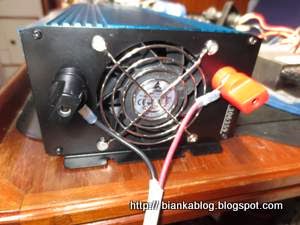bank does come in handy after it is charged up at anchor. One can easily tap into it from time to time and then just let the solar panels and wind generator recharge things without ever having to fire up the generator. So it seemed like it was a good idea to spring for a 48 volt to 120 volt sine wave inverter to not only charge the Electric Paddle battery but, also be able to use it for other needs like running the Wet/Dry Micro Vac for quick clean ups, using 120 power tools and maybe a bread maker or microwave down the road. The inverter I decided on was the AIMS PWRI150048S 1500 Watt Pure Sine Wave Power Inverter, 48 Volt
When I first bought the Thoosa 9000 electric propulsion system for the boat I also purchased a 48 volt to 12 volt converter. It is a 300 watt Sevcon converter. I mostly use it for powering the laptop while at anchor to blog and search the Internet. It works well with the 12 volt power supply I bought for the computer. I've also used it to temporarily power the on board Engel Refrigerator - Freezer
There is a bit of size difference but, the Inverter is five times as powerful and can be used to power more things including the laptop and Engel along with a number of 120 volt devices. Connection of the AIMS Inverter to the 48 volt battery bank is by two terminals on the back of the unit:
The front of the unit has two AC outlets, an on/off switch and two status LED's and a ground lug:
The AIMS Inverter also comes with a handy keychain type rf remote switch so you can mount the unit in a remote location on board but, still turn it on and off when needed without having access to the front panel on/off switch. For now I have mounted the unit in the main cabin where I can see the status lights and have access to the on/off switch and AC outlets. I am also using the 15 amp tap of the 48 volt Morningstar solar controller to provide power for the inverter via 75 amp Anderson Powerpole connectors:
This means I am limited to only using around 700 watts of the 1500 watt potential on the inverter. But, for now that's all I need. So far the AIMS Inverter has come in very useful primarily for charging the Electric Paddle battery without requiring I run the generator for hours and it will come in even more useful to power other devices in the future.











-1.jpg)
.jpg)





1 comment:
Good idea Mike. In fact I plan to do the same, albeit slightly differently. I'll have a standalone AGM inverter pack. The batteries will go where my old stater and leisure batteries used to be.
So I'll be using 2 x Victron 12V 66AH @C20 rate AGMs in series giving 24V 66Ah. Can't get any bigger in the old battery boxes. A Victron Blue Power IP65 24V/8Amp charger will come of my 230V shore supply. A Victron Phoenix 24V/800 Watt Inverter will provide my 230Volt AC power. I'll use it for charging my electric outboard battery which is a 12V 38AH Victron AGM, via a Blue Power IP65 12V/7A Charger.
So nothing that different so far. However sometimes I don't want to start my small genny, which is currently a 500 Watt Honda and going strong after 20 years. Switching to a Honda EU10i 1 kW. So, if my main propulsion bank is 80% charged i.e bulk has finished and I don't want to run the genny inefficiently or have the noise - then a simple fly lead from the inverter back into my shore power supply when away from dock and it'll silently charge my main bank in absorption/float mode.
I know it is not efficient that way but if you arrive at anchor late at night and want silence than a handy way to top off the main propulsion bank. My main charger is a Victron Phoenix digital 4 stage adaptive 24V/25Amp i.e 600 Watts so the 800 Watt inverter can handle that.
My 1kW generator will also handle charging main, inverter and outboard batteries and as I only take 750 Watts on the main electric drive to do 4 knots, that 600 watt main charger is enough to go at close to that all day with 5L of petrol, used as a range extender. If that had been my old diesel I'd have used 3 times as much fuel. Just goes to show how much more efficient electric propulsion is!
Post a Comment